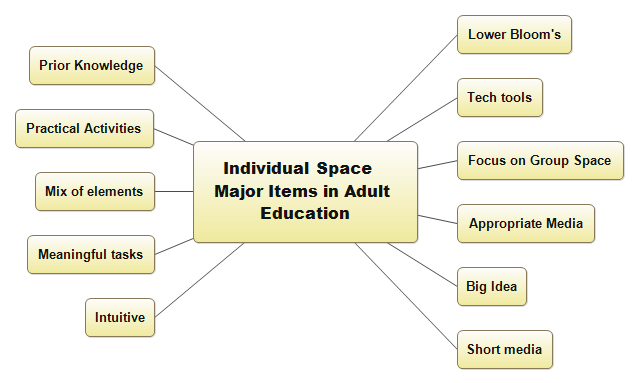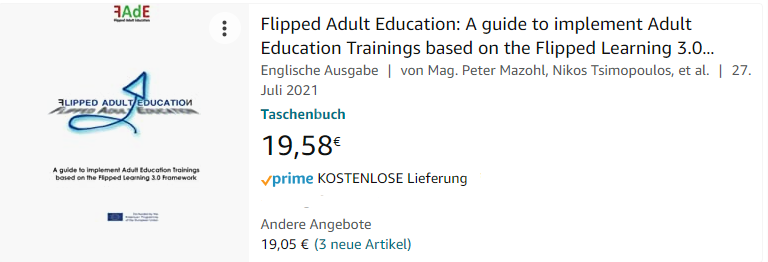A basic approach to Flipped Learning is to split the instructions and use two different learning spaces for them. The one learning space is the so-called individual space. Here, the learner learns alone and focuses on things that fall within the domain of knowledge and understanding. It is no coincidence that these two properties occupy the lowest levels in Bloom’s taxonomy1). The knowledge acquired can then be used in the Group Learning Space, where all learners are gathered to deepen and further develop skills and abilities through active learning.
In this post, we refer to the 187 Global Elements of Efficient Flipped Learning, the structure of the Flipped Learning 3.0 Framework.
Individual Learning Space
Errol St. Clair Smith, the Director of Global Development at Flipped Learning Worldwide, developed a 12-sectored color wheel showing the twelve sectors of 187 Elements (as mentioned above). These elements create the frame to master the individual space. Here is an overview of these elements (in the context of the individual space).
This group addresses the learner as a single person and the impact of the teacher/trainer on the learner. An essential focus is set on pre-class learning and the benefits or added value for the learner, as well as the skills the trainer must have to implement in this pre-class training for the learner. Here are the major elements, as defined in the framework. The project team left some comments below the definition.
- Lower Blooms
Use lower levels of Bloom’s Taxonomy (remembering, understanding)
Consider cautiously which content is needed for the pre-knowledge. You should use an appropriate development concept for your course design (for example backward design) to be sure to have created a comprehensive individual space. - Learn Tech Tools
Learn how to create flipped videos and other flipped media using the tools at your disposal.
Technology plays an important role. Be aware to use technology in a meaningful scope. Consider that a mix of technology and analog methods can often be best for learning success.
Do you know the term “Multiple Devices”? Read more about devices and problems with devices in learning and training. - Focus on Group Space
Focus on what you want to achieve in the group space when creating the individual space pre-work.
What you have prepared in the Individual space should be the base for the group space. On one hand, do not overload the Individual space, on the other hand, please keep in mind essentials. - Appropriate Media
Strategically choose an appropriate medium for the pre-class media (text, annotated whiteboard video, screencast, plain video).
Select the media that fits best the purpose. Adapt the use of media to the target group. A course for participants who only have smartphones as a device for eco-social reasons must be designed differently than for a learning group that has tablets and laptops.
Here you may read more about “Multimedia-based and Interactive Content“ - Pre-Class has Big Idea
Make sure pre-class media contain the big idea. - Short Media
Make sure pre-class media are short.
There exist numerous studies about the length of a video and the efficiency in the learning process. Please check this issue seriously! - Intuitive
Make sure pre-class media are intuitive.
Keep it small, simple, and easy to understand. Learners do not want to read long instructions on how stuff works. - Mix of Elements
Ensure that videos include an appropriate mix of text, pictures, discussions between people, short integrated films, instructor writing, and narration.
Always the same is boring and annoying. Provide variety in learning through targeted, well-fitting tasks of different kinds.
Example: A preparation unit should not only consist of videos (a trend that can often be observed today). Individual videos make sense, but then in between can be a practical task with some reading and a related activity, followed by a multimedia summary. - Practical Activities
Include practical, concrete activities that students can engage in during or after the pre-class media and tasks.
Practical tasks that are meaningfully built into the learning process are “the salt in the soup of the learning process”. - Connect Prior Knowledge
Introduce pre-class media with a prior knowledge question to activate student thinking.
This is quite true and important, but difficult: adult groups are rarely homogeneous in their pre-education, in the age group as well as in their professional practice. All this makes it difficult to implement a meaningful and useful reflection on the materials that can serve as pre-education.
Further Readings
An appropriate description of the Flipped Learning 3.0 Framework is available in the book Flipped Adult Education”, an outcome of this project. The book can be ordered from Amazon (in the English language).
Bloom’s Taxonomy: fctl.ucf.edu/teaching-resources/course-design/blooms-taxonomy/
1) Bloom’s taxonomy is a classification system used to define and distinguish different levels of human cognition—i.e., thinking, learning, and understanding. Bloom’s taxonomy was developed to provide a common language for teachers to discuss and exchange learning and assessment methods.


